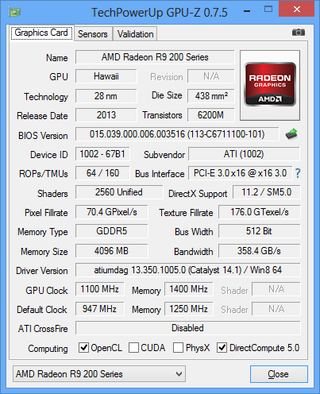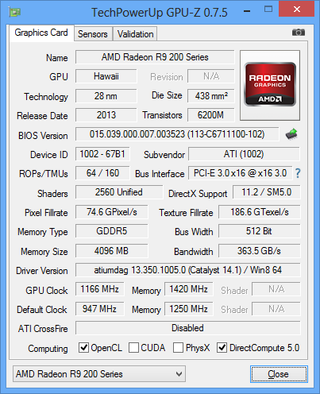CryoVenom R9 290 Review: Water Cooling With A Warranty
Liquid cooling solves the thermal challenges presented by AMD's Hawaii GPU much more elegantly than a big heat sink and loud fan. But the requisite parts also add cost. Does VisionTek's CryoVenom R9 290 deliver maximum performance at a fair price?
Overclocking
Benchmark charts look a little bare with only two data points on them. When I reviewed my last water-cooled card, I filled-out those graphs with four unique configurations, including the Quiet and Uber firmware switch settings. This made particular sense in that story because PowerColor's LCS AXR9 290X's Uber mode actually applies an overclock.
VisionTek's CryoVenom R9 290 doesn't offer that provision, and AMD recently narrowed the difference between air-cooled cards by overriding the Quiet mode's fan speed ceiling using its Catalyst driver. Extensive comparisons between the two BIOS settings suggest that there's really no performance difference between them, though Quiet mode does drop to lower power consumption at idle.
So, I decided to start today's review with overclocking, which lets me use the factory and overclocked settings to generate some additional benchmark results.

The air-cooled, retail-purchased Radeon R9 290 from Sapphire is the card to beat for VisionTek's liquid-cooled contender. Using MSI Afterburner, I set the maximum power limit (+50%) and MSI’s custom fan curve (100% at 90 °C) to keep clock rates steady. But I was only able to hit 1100 MHz at those settings. Still, it’s a steady 1100 MHz, which is roughly 50% faster the frequency floor you'll see when the R9 290 throttles all the way down.
I’m incredibly critical of marketing material, so I was dubious of this quote from VisionTek’s product description:
Obtaining maximum performance from the CryoVenom R9 290 couldn’t be easier. You just enter the specifications from the included build sheet in the Catalyst Control Center and in less than a minute, the CryoVenom R9 290 can safely deliver up to 1175 MHz GPU speed...a 24% increase from the stock setting of 947 MHz. The memory clock speed is also increased to 1450 MHz...16% faster than the 1250 MHz stock setting.
So, what did I get?
Stay on the Cutting Edge
Join the experts who read Tom's Hardware for the inside track on enthusiast PC tech news — and have for over 25 years. We'll send breaking news and in-depth reviews of CPUs, GPUs, AI, maker hardware and more straight to your inbox.

Hitting a 1160 MHz core clock and 1440 MHz GDDR5 memory frequency is still in the neighborhood of what I was told to expect. Then again, I'm a little fussier than the marketing folks when it comes to things like exact specs and game stability. I did, after all, increase the power limit by 50% to prevent the card from throttling back the instant I needed its maximum performance.
-
OttoD Would have loved Reference vs. Custome Aircooling vs. water, is it worth going from example Sapphire Tri-X to water? theres really no need for reference coolers in no one in there right mind will buy one of those unless its for fitting water your self.Reply -
hansrotec Moving to water cooling with my 7970 was night and day in terms of temps and noise. worth every penny. right now im planning a cooling overhaul to drop the temp while not needing the pump to speed up as much - larger/ more rad and a new pump started with an swiftech h220 and added on an EK 7970 lightning block with a 120mm rad and small reservoirI will say while i could go back to the CPU being air cooled i could not go back to the GPU being air cooled.Reply -
SchizoFrog Just got to love these so called 'full cover water blocks' that only cover 80% or less of a GPU card. Yes, they may cover all the necessary components on the PCB but it looks half finished and leaves the card looking ugly with the exposed components that remain and for the money you pay, would it be too much to ask to extend it to cover the full length of the GPU?Reply -
tcb1005 Do you ever have to clean out your water loop? If so, I think I would go with the air cooled.Reply -
Crashman Reply
This one has been clean for years because it contains antifreeze and has all copper parts. My mixed aluminum/copper systems were horrrrrrrible for building up crud.12852347 said:Do you ever have to clean out your water loop? If so, I think I would go with the air cooled.
-
dgingeri That math seems wrong to me. Sure, the card, the water cooler, and the backplate are the right components, but since it doesn't come with an air cooler, and the water cooler is less complicated to put on, and the fact that the water cooler is more reliable due to now having a fan, it seems to me that the water cooled version should be cheaper, or at the very least the same price as an air cooled version. This is a ripoff.Reply -
Crashman Reply
Thanks, but VisionTek doesn't make the cooler, they buy it. Same with the card, they buy that with the air cooler and I've never paid more than $20 for "overstock" replacement coolers on eBay.12853738 said:That math seems wrong to me. Sure, the card, the water cooler, and the backplate are the right components, but since it doesn't come with an air cooler, and the water cooler is less complicated to put on, and the fact that the water cooler is more reliable due to now having a fan, it seems to me that the water cooled version should be cheaper, or at the very least the same price as an air cooled version. This is a ripoff.
Go look at the price of the acrylic/nickel block and the backplate. Assume they're stockpiling the leftover air coolers at some cost and will sell them in the far future for about the cost of stockpiling them.
-
dgingeri So, you're telling me they buy the cards with the air coolers pre-installed and then replace them with the waterblock? That's about the most asinine idea ever. They could easily buy the cards from an OEM supplier, like Sapphire, without the cooler and just add the water block. The air coolers are more expensive than $20, that's for sure. The copper alone is probably worth $15, just for recycle value. (I got $15 each from a copper recycler for a couple server CPU coolers I pulled from a dead server someone asked me to recycle a couple weeks ago, and those were less copper than I've seen on most GPU coolers these days. The CPU coolers were just a 1/4" plate barely bigger than the CPU socket with 1" tall thin fins soldered onto it.) A GPU cooler for an R9 290 is probably about $40-50 to the card maker, maybe $10 less than that water block. They'd save a bunch getting the card from an OEM supplier without the air cooler and installing the waterblock. If they're actually doing as you say, they're wasting tons of money, and the management should probably be fired for incompetence.Reply -
Crashman Reply
Until recently the only way to buy cards was complete from AMD. And the cooler it came with was incredibly cheap.12854116 said:So, you're telling me they buy the cards with the air coolers pre-installed and then replace them with the waterblock? That's about the most asinine idea ever. They could easily buy the cards from an OEM supplier, like Sapphire, without the cooler and just add the water block. The air coolers are more expensive than $20, that's for sure. The copper alone is probably worth $15, just for recycle value. (I got $15 each from a copper recycler for a couple server CPU coolers I pulled from a dead server someone asked me to recycle a couple weeks ago, and those were less copper than I've seen on most GPU coolers these days. The CPU coolers were just a 1/4" plate barely bigger than the CPU socket with 1" tall thin fins soldered onto it.) A GPU cooler for an R9 290 is probably about $40-50 to the card maker, maybe $10 less than that water block. They'd save a bunch getting the card from an OEM supplier without the air cooler and installing the waterblock. If they're actually doing as you say, they're wasting tons of money, and the management should probably be fired for incompetence.
AMD recently released these to distribution by manufacturing partners, so maybe they can now get them bare. But they couldn't when these were launched, and this is a launch card. Since I don't know the full details of AMD's recent move, I cannot comment further.
Most Popular


